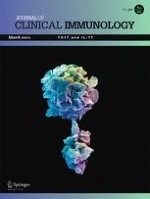Erschienen in:

01.03.2010
The Vagus Nerve and Nicotinic Receptors Involve Inhibition of HMGB1 Release and Early Pro-inflammatory Cytokines Function in Collagen-Induced Arthritis
verfasst von:
Tong Li, Xiaoxia Zuo, Yaou Zhou, Yanping Wang, Hanping Zhuang, Lingli Zhang, Huali Zhang, Xianzhong Xiao
Erschienen in:
Journal of Clinical Immunology
|
Ausgabe 2/2010
Einloggen, um Zugang zu erhalten
Abstract
Objectives
The cholinergic anti-inflammatory pathway, a vagus nerve-dependent mechanism, inhibits cytokine releases in models of acute inflammatory disease. We investigated the efficacy and elucidated the possible mechanism of the cholinergic anti-inflammatory pathway on collagen-induced arthritis (CIA) in mice.
Methods
Fifty-six male DBA/1 mice were divided into four groups: control mice (sham vagotomy + phosphate-buffered saline; shamVGX+PBS), model mice (shamVGX+PBS+CIA), vagotomy mice (VGX+PBS+CIA), and nicotine (Nic) mice (shamVGX+Nic+CIA). We subjected mice to left-side cervical vagotomy 4 days before induction of arthritis. Mice in the nicotine group were injected with nicotine (250 μg/kg per day) 4 days before arthritis induction. Arthritis score was measured and histopathologic assessment of joint sections carried out. The concentration of tumor necrosis factor (TNF)-α, interleukin (IL)-6, and IL-10 in serum were evaluated by ELISA. Expression of high-mobility group box chromosomal protein 1(HMGB1) was evaluated by immunohistochemical staining of joints.
Results
Vagotomy exaggerated, whereas nicotine attenuated, clinical arthritis. Histopathologic findings confirmed that nicotine reduced infiltration of inflammatory cell and bone destruction. Expression of TNF-α and IL-6 decreased in nicotine-pretreated mice compared with model and vagotomy mice; IL-10 levels were not significantly different between the model group and nicotine group. Nicotine reduced the expression and translocation of HMGB1 in the inflamed joints of CIA mice.
Conclusions
The cholinergic anti-inflammatory pathway has an anti-inflammatory role in the pathophysiology of rheumatoid arthritis (RA) via inhibiting HMGB1 release and early pro-inflammatory cytokines function. Study of this pathway could be used for RA therapy.











